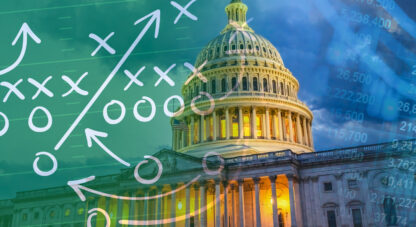The Next FOMC Meeting Could Be Historic
This week, HAI is being composed in the skies high above America—regrettably, in a plane with no Wi-Fi. A popular saying about “the best laid plans” does come to mind. Nevertheless, given the constraints, HAI will be brief and try to set the stage for what this author believes will arguably be the most significant and consequential Federal Reserve FOMC policy meeting of the ongoing hiking cycle to date.
In the wake of Covid and the unprecedented, massively stimulative monetary and fiscal policy response, bubble markets turned super-bubble. Global inflation, previously confined to financial asset prices, subsequently jumped the fence and spread dangerously into consumer prices. The Fed, better late than never, responded. It launched a series of aggressive rate hikes and initiated quantitate tightening (QT) to restrict financial conditions enough to slow the economy and thereby bring consumer price inflation back down to the Fed’s 2% target “unconditionally.”
The risk of completing the job with such blunt measures in the context of a fragile, record debt-laden, interest rate-sensitive financial system was always recession and perhaps a systemic accident. At present, the economy has weakened substantially. Despite this week’s positive GDP number, as EPB Macro Research explains, “Consumption plus investment makes up about 88% of real GDP. This strips out government spending, inventory, and exports. This high-level ‘core’ GDP was flat in Q4… Core GDP is not accelerating and is nearly recessionary… The cyclical and high-power (leading) elements of the economy continued to decelerate sharply in Q4 while real GDP ticked higher. This means real GDP is supported by non-cyclical or ‘irregular’ factors while the engine of economic growth is in recessionary territory.” Furthermore, the leading economic indicators broadly point to a further weakening of the economy into a full-blown recession. As expected, inflation has begun to fall substantially from the peaks of last year, putting the economy on track for a rather typical tightening cycle leading to recession and falling inflation.
To bolster the point, in recent weeks, HAI has pointed out a notable deterioration in economic data since December. First it was the December ISM Purchasing Managers Index (PMI). Then it was the NFIB small business outlook cratering along with a notable drop in profit trends. Last week’s Empire State manufacturing data spoke the same recessionary language. This week it’s the Conference Board’s Leading Economic Index (LEI) banging the recession gong in convincing fashion.
The LEI is a composite index of 10 key leading economic variables dating back to 1959. This week’s update indicated a worse-than-expected 1.0% drop (-0.7% expected) for the December index reading. It was the LEI’s 10th straight monthly decline, which, incidentally, gives the current streak the dubious distinction of being the longest set of consecutive declines since Lehman Brothers collapsed during the great financial crisis era. The index has now declined to levels that have historically been accompanied by recession. This LEI recession signal is number nine, and follows a perfect eight for eight dating back to 1959.
In addition, there are corroborating indications of recession embedded in the data that add credence to the overall LEI recession call. December was the third straight LEI decline of at least 1% after November was revised lower. Since the index’s 1959 inception, this is the 20th instance of a three-month consecutive drop of this magnitude. The previous 19 instances all occurred during recessions. In addition to the three-month trend, the six-month and twelve-month trends are also 100% recessionary according to history. Furthermore, the LEI weakness is broad-based. The breadth of weakness over the last three-months has 20 historical parallels. Of those prior instances, 18 occurred during recessions, one occurred a month before a recession, and the remaining case happened three months ahead of a recession.
This week, we also had the preliminary January S&P Global US PMI data released. Results were slightly better than expected, but remain firmly in contraction. In other words, according to S&P, both manufacturing and services continue to contract, just at a slightly slower pace. Preliminary January S&P Global US Manufacturing PMI came in at 46.8, while Services PMI came in at 46.6. Readings below 50 signify outright contraction. Along with the December Institute for Supply Management PMI readings, the current S&P data provides redundant confirmation of contraction in both the services and manufacturing sectors.
Commenting on the US flash PMI data, Chris Williamson, Chief Business Economist at S&P Global Market Intelligence said, “The US economy has started 2023 on a disappointingly soft note, with business activity contracting sharply again in January… The rate of decline is among the steepest seen since the global financial crisis, reflecting falling activity across both manufacturing and services.”
Significantly, Williamson pointed out an even more problematic finding embedded in the data. He added, “the worry is that not only has the survey indicated a downturn in economic activity at the start of the year, but the rate of input cost inflation has accelerated into the new year, linked in part to upward wage pressures, which could encourage a further aggressive tightening of Fed policy despite rising recession risks.” The picture Williamson is painting, one of a Fed forced to stay hawkish with higher rates for longer into a developing recession, is a portrait of a hard landing getting harder.
Chris Williamson’s point, however, on the reacceleration of input cost pressures is key. It brings us back to the Fed’s big moment next week. The market has been loosening financial conditions dramatically since October, and is ignoring the hawkish policy guidance from the Fed. It assumes that one way or another the Fed hiking cycle is almost over. Despite the Fed’s jawboning to the contrary, markets are completely ignoring the Fed and anticipating an aggressive rate-cutting cycle starting later in 2023 and continuing into 2024.
Rallying markets and loosening financial conditions are signs of markets front-running this expected eventuality. At the same time, previously unanticipated global growth impulses are suddenly expected from both China’s Covid reopening and accompanying government stimulus, along with better than expected growth out of Europe after energy-crisis fears failed to hit European growth as hard as feared. In short, a loosening of financial conditions in the US risks supporting growth at the same time that European growth outperforms and China reopens.
All told, without a continued decline in growth, the risk of reaccelerated inflation is very high. What Chis Williamson observed in reaccelerating PMI input cost inflation is also showing up in a rebound of many commodity prices. With such chronic supply shortages across many key commodities, any growth uptick leads to an increased demand impulse, which, into tight supply, drives higher prices that reaccelerate inflation. So, without a Fed that maintains the fight and is willing to apply a heavy boot to the neck of growth, the inflation fight and the Fed may be back to square one.
Next week, the Fed can risk letting the situation slip dramatically out of its control or it can fight back, try to re-grasp the reins of financial markets, retake the narrative, reset expectations, and finish the job it set out to accomplish. Failure to do so will be the clearest indication yet that Powell and the Fed have already lost control and all credibility, and have settled for the risk of fire in a devastating 1970s-style reaccelerating inflation crisis over ice in the form of recession, pain, and an inflation reset. The implications for various asset classes loom large.
As HAI stated last week, the market is in a “temporary Goldilocks” zone, and is relatively sanguine at present given the multitude of factors now driving a soft landing narrative. Market sentiment, so pervasively bearish throughout 2022, has whipsawed dramatically and has overwhelmingly embraced the green shoots of hope. After ending 2022 with recession expected, a shocking Morgan Stanley survey out on Monday suggests that an astonishing 90% of investors/traders are now swelling the ranks of the “soft landing” crowd.
While the market is suddenly, overwhelmingly, and enthusiastically courting the soft-landing narrative, the Equity Strategy team at Barclays doesn’t see Goldilocks as marriage material. This week, the bank warned, “the current Goldilocks environment will not last; the ‘soft landing’ narrative has been overstated.” JPMorgan admitted similar misgivings regarding the fate of Goldilocks, pointing to shades of late 2007 when indicators of recession were flashing red before the China wild card showed up to “ruin” the analysis. As JPM said, as in the run-up to the great financial crisis, “elevated US recession odds are once again intersecting with powerful China growth tailwinds.” Recall that recession and crisis won that last tug-of-war in spectacular fashion. In addition, referring to the ever-deepening recessionary inversion at the front end of the yield curve (now the most inverted since the late 2000 popping of the tech bubble), JPMorgan added that, “we are respectful of the message [fixed income] markets are giving us, which is that a recession may be looming more imminently.”
HAI agrees that the soft-landing narrative is overstated, and that rumors of the hard landing’s demise have been greatly exaggerated. But for that to remain the expectation the Fed will have to push back against the market’s current loosening of financial conditions and maintain a credible inflation fight for longer.
Once the bubble graduated to super-bubble and severe consumer price inflation subsequently materialized, it seemed inevitable that the Fed would reveal whether 1) it has a capable monetary policy brake, and 2) whether it would be willing and/or able to use it, as Paul Volker did. The Fed must choose between potentially the hardest of hard landings or a premature pivot that expands USD liquidity within still-elevated inflation. Choosing the latter “solution” would essentially mean there is no turning back from our credit bubble economy and inflation as policy. All eyes will be on Jay Powell next Wednesday.
Weekly performance: The S&P 500 was down 2.47%. Gold was up 0.01%, silver lost 1.30%, platinum was lower by 2.96%, and palladium lost 7.17%. The HUI gold miners index shed 0.14%. The IFRA iShares US Infrastructure ETF was up 2.12%. Energy commodities were volatile and lower on the week. WTI crude oil lost 2.40%, while natural gas was hit again, down another 10.24%. The CRB Commodity Index was down 0.29%, while copper was down 0.71%. The Dow Jones US Specialty Real Estate Investment Trust Index was up 1.79% on the week, while the Vanguard Utilities ETF (VPU) was down 0.27%. The dollar was slightly lower by 0.06% to close at 101.72. The yield on the 10-yr Treasury was up 4 bp to end the week at 3.52%.
Best Regards,
Morgan Lewis
Investment Strategist & Co-Portfolio Manager
MWM LLC















